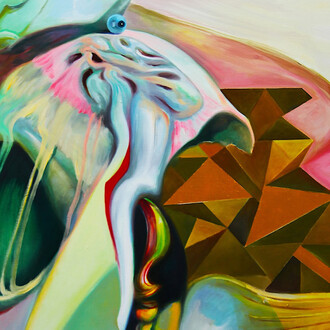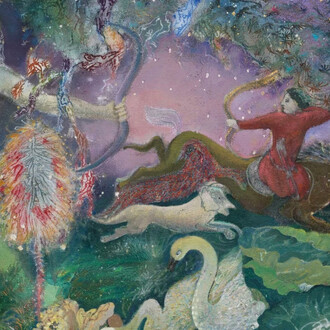On September 18, Venus Over Manhattan will open American realism today: Robert Lobe and Neil Jenney, featuring a selection of both early and recent works by two of the most influential artists of the American Realism movement. Lobe and Jenney first met in New York City in 1967, and for more than 50 years, they have pursued their distinct artistic visions, shaped by and in contrast to the prevailing movements, trends, and styles of the city’s art scene. Their careers and friendship capture the spirit of innovation that has always made New York a creative epicenter and hub for some of today’s most celebrated artists and thinkers.
Lobe and Jenney were first presented together in the group exhibition Anti-illusion: procedures/materials at the Whitney Museum of American Art in 1969. Their individual works in the acclaimed 1987 Whitney Biennial drew critical praise, with the New York times and TIME magazine citing them as among the most inspired and distinct in the presentation. The latter publication, in particular, celebrated Lobe for his “haunting” engagement with nature and Jenney for his unique evocations of the sublime in landscape. In the years since, their practices have evolved in both intersecting and singular ways. The forthcoming presentation at Venus Over Manhattan offers a unique opportunity to see their work together again and consider their profound impact on the trajectory of American art. The exhibition will remain on view through November 16 at the gallery’s location at 55 Great Jones Street.
To further engage audiences with their visions, works, and longstanding friendship, the gallery will host a panel discussion with the artists on September 26.
Throughout his career, Neil Jenney has sought the classical idea of truth in art, taking realism as both a stylistic and philosophical pursuit. His work integrates form and content, while eschewing the decorative, superficial and overly expressive. American realism today: Robert Lobe and Neil Jenney includes a selection of his renowned Bad paintings, which the artist produced throughout 1969 and 1970 and marked his formal transition from sculpture and assemblage to painting. With his Bad paintings, produced in acrylic, Jenney actively pushed against the prevailing focus on Pop art, which he saw as a veneration of consumerism. By contrast, his new paintings engaged with nature as something real, tangible, and profound. The paintings depict figures and objects within broad expanses of grass and blue skies. Rendered in a loose, gestural style, the Bad paintings leveraged the expressiveness associated with abstraction to capture and reveal the real.
The Bad paintings—named after an exhibition organized years later, in 1978, at the New Museum by Marcia Tucker—represent a pivotal moment in Jenney’s career and the vision of Realism he would continue to pursue for decades. The exhibition also includes the 2023 painting Texting and talking, highlighting the trajectory of Jenney’s style and approach into the present moment. The painting is among the artist’s recent interpretations of his Good paintings, which reflect Jenney’s refined use of paint and line in his depictions of nature and landscape as well as his growing engagement with issues of social progress.
Nature is also a central orienting focus in sculptor Robert Lobe’s work. In the early 1970s, Lobe began creating works with motifs inspired by nature and his early sculptures, made entirely of wood, engaged with the simplicity of Minimalist volumes and forms. An unexpected revelation occurred when Lobe was repairing a 1958 Aston Martin he purchased: many of the parts were made from aluminum and the lightweight materials offered an interesting opportunity for further exploration. To catalyze his experimentations, Lobe studied the ancient metalworking technique of repoussé, in which sheets of metal are overlaid on objects to be reproduced. This led to the artist’s innovative approach to creating sculptures by encasing trees and rocks in aluminum using methods similar to repoussé and chasing. American realism today: Robert Lobe and Neil Jenney includes a selection of these sculptures, produced between 1985 and 2022, capturing the range and depth of the works through time.
These sculptures serve as an interpretation of nature disrupted and reshaped by human intervention and challenge conventional views of natural beauty as serene and perfect. At the same time, the contrast of natural and man-made materials reflects on the realities of nature in which different living organisms fight for resources and depend on each to maintain a thriving ecosystem. In this way Lobe’s work is both poetic and deeply real, engaging with subjects profoundly intricate and necessary to survival. Offering insights into environmental issues and human interactions with natural landscapes, Lobe’s practice is a meditation on the interplay between nature, culture, and technology.
“Robert Lobe and Neil Jenney have a long history as artists, friends, and icons of New York’s ever evolving and thriving artist community. Their careers and creative lives are deeply interwoven, and we are delighted to have the opportunity to bring their work together in the forthcoming exhibition, to engage new and existing audiences with their practices, past and present, and with the incredible impact they have on the history and continued evolution of art”, said Adam Lindemann, founder of Venus Over Manhattan.
Robert Lobe (b. 1945, Detroit, MI) is an acclaimed American sculptor, who lives in New York and works in New Jersey, along the Appalachian Trail at Harmony Ridge Farm and Campground. Lobe’s works are featured in important public collections such as the Brooklyn Museum, the National Gallery of Art, and Whitney Museum of American Art. His recent exhibitions Superstorm at Duarte Square in New York, NY (2018); Private viewing at West Broadway Gallery, New York, NY (2015); Field studies at Mohonk Preserve, Gardiner, NY (2015); and Robert Lobe: in the forest drawn of metal featuring forest projects, collaborative works with Kathleen Gilje at Grounds for Sculpture, Hamilton, NJ (2015). He holds a B.A. from Oberlin College (1967) and has received National Endowment for the Arts Fellowships in 1979 and 1984, as well as an award from the Joan Mitchell Foundation in 2001 and a John Simon Guggenheim Fellowship for Creative Arts in 2018.
Neil Jenney (b. 1945, Torrington, Connecticut) is a renowned American artist, who lives and works in New York. Jenney’s works are held in some of the most prestigious public collections across the globe, including the Metropolitan Museum of Art, Museum of Modern Art, Whitney Museum of American Art, Los Angeles County Museum of Art, and Tate. Recent exhibitions of his work include Neil Jenney: bad paintings at Tobias Mueller Modern Art in Zurich, Switzerland (2023); Framing nature’s paradox at the Morris Museum in Morristown, NJ (2023); Neil Jenney: American realist at the New Britain Museum of American Art in New Britain, CT (2018); and Neil Jenney: North America at the Aldrich Contemporary Art Museum in Ridgefield, CT (2007). Early group exhibitions of note include the Whitney Biennial (1969, 1973, 1981, and 1987) and Representations of America (1977–78, organized by the Metropolitan Museum and the Fine Arts Museums of San Francisco) at the Pushkin Museum, Moscow; Hermitage, Saint Petersburg; and Palace of Art, Minsk, Belarus.
















